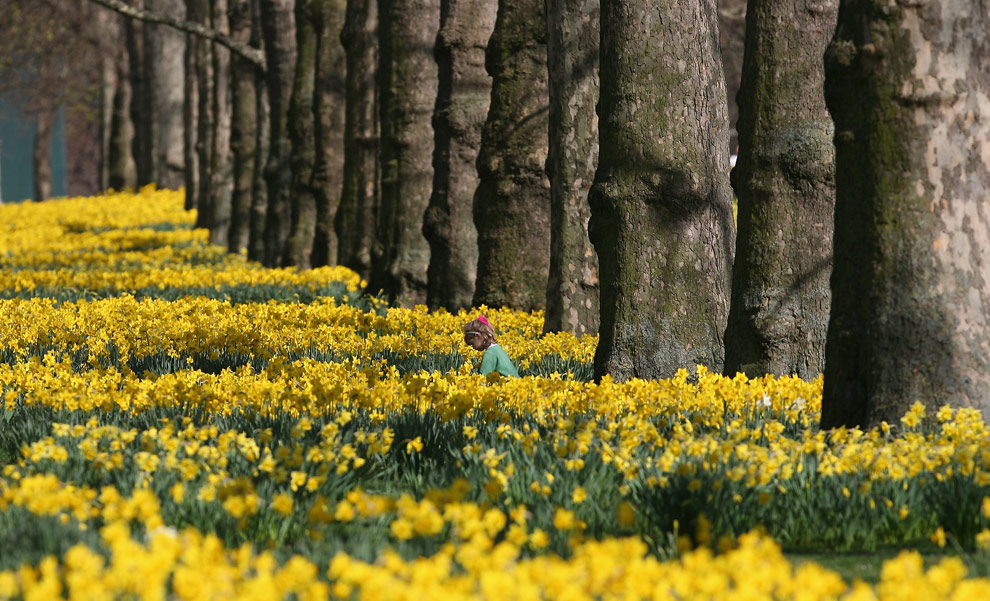On May 16th, 2009,
the Election Commission of India announced the results of its recent
month-long India-wide election for their lower house of Parliament - the
largest democratic election in the world. An estimated 714 million
voters (from a population of 1.2 billion) were eligible to cast their
vote in one of five separate phases at over 800,000 polling stations,
starting on April 16th. Logistically difficult, massive in scale, and
opposed by various rebel groups, separatists and protestors, the
elections still managed to be held with minimal disruption, with an
average voter turnout of greater than 56%. The big winner was the the
Indian National Congress party, which will form the new government under
the incumbent prime minister Manmohan Singh. As with any photo story
from India, it is impossible to capture every aspect in just a handful
of pictures - collected here are only some of the scenes that played out
across the nation over the last month. (40 photos total)
January 20, 2010
January 13, 2010
Batman fans
I have known Batman since my childhood more than 40 years ago (now I'm over 59). That time I lived in Chonburi Province and Batman was on monochrome TV, (TV was very rare & more expensive in that time) and cartoon magazines. Batman appeared with his younger assistant, Robin, Yesterday Batman series were interesting, exciting and more dramatic actions. These are some funny pictures of the Batman fans.

The baby wears the Bat mask, well he is the super hero.
January 8, 2010
ปฏิมากรรมน้ำแข็ง Ice Sculpture
January 7, 2010
Tsukiji Fish Market in Tokyo
Tsukiji Fish Market in Tokyo
The world's largest fish market in Tokyo and called Tsukiji. Perhaps the word is not quite accurately convey the idea of the biggest on the planet Focus fish trade. Then the following figures: Japan accounts for ten percent of the global fish consumption. Simply put, every tenth caught in oceans and seas fish gets to the Japanese. And 87% of the wholesale fish and seafood market in Japan focused on Tsukiji. In absolute terms, it is 660 thousand tons per year.(Total 19 photos)

Source: Zhzhurnal / http: //kirulya.livejournal.com/

1)
Even the name of the Tsukiji is directly related to the sea, because
the sea of this area of Tokyo, literally and arose: Tsukiji
translated as "made land", ie land reclaimed from the sea.

2) Long before dawn, hundreds of trucks come in Tsukiji - driven fish and marine reptiles from around the world. Barely glimmer light begins auction.

10)
- and hundreds of thousands of different sea creatures, the vast
majority of which a foreigner sees for the first time in my life, and
now you do not suspect any of their existence, even more so, that all
that can be eaten.

11)
People who are busily walking about side by side with you on fish
series, by the way, deserves perhaps more attention than the fish
itself. It's idols in the world of Japanese haute cuisine. All
the most famous chefs of the best restaurants and hotels in Tokyo-class
begin their morning with the obligatory trip to the Tsukiji, where the
catch is taken for its culinary achievements. In general, fish belly Tokyo - a Mecca for gourmets.

12)
When the eye becomes accustomed to the incredible variety of fish and
shellfish - if this is possible at all to get used to - the next thing
you notice is the almost complete lack of fish odor. Boxes with marine catch comes with seiners have carefully sorted; fish and seafood washed, as a first-grader at the school line on 1 September. Considering
all this exciting splendor, should, however, not to relax and look at
the two on the sides: the narrow rows dashing sweep incredible design
motorized carts with boxes of fish. Trolley mounted on a metal barrel with a burning coal. On top of the barrel wheel.

13) Motor vehicles, probably working as a locomotive firebox, giving this unit on wheels pretty decent speed. Japanese stands on the cart and steers. Where he taxied the next moment, knows only himself. Probably
soon Teamsters with their antediluvian carriages replace any
intelligent machines or robots, but from Tsukiji lose some of its charm
today.

15) At the Tsukiji daily selling 3000 tuna weighing over 200 tons. Of one thousand shops here almost half focuses only on the tuna, or maguro in Japanese. However, one name in the case of tuna in Japan will not be enough. Species of tuna there are so many; Japanese are more likely appreciate the so-called "blue" tuna. And it - the fatty part of the underbelly, called "Rotor".

16) In view of this meat tuna is not a raspberry-red, which is usually served in sushi bars, and pink with white veins. It is from the "Rotor" obtained the best gourmet sushi and sashimi. The cost, of course, appropriate. At the fish market Tsukiji pounds of "blue" tuna is worth an average of $ 150; "Rotor" of such fish will be even more expensive.

18)
Here it is - a traditional green Japanese horseradish wasabi (here it
is not a powder, as in commercial establishments, and freshly prepared)
January 5, 2010
Signs of Spring สัญญาณแห่งฤดูใบไม้ผลิ
The Northern Hemisphere is once more beginning its lean towards the Sun, with the spring equinox taking place last Friday, March 20th. People all over are welcoming the spring sunshine and new growth in many ways - from Stonehenge and Mayan pyramids to Dutch meadows and Texan beaches. Here is a collection that shows some of the signs of spring as we shake off the last bits of winter. (29 photos total)
Erotica Cars ชมรมคนรักรถเก่า
Special Experienced Teacher
Information and Communication Technology Strand
Ford - Mastang
Ford "Mustang" was the hottest car of 1970s. Its design is interesting and attractive for whole people. As years go by Ford Mustang is always valuable.
ฟอร์ดมัสแตง (ม้าป่า) เป็นรถยนต์ฮอตในช่วงทศวรรษ1970 การดีไซด์น่าสนใจ เตะตาน่ายล สำหรับทุกคน แม้กาลเวลาจะผ่านพ้นไปแล้ว แต่คุณค่าของเจ้าม้าป่าตัวนี้ก็ไม่ได้ลดลงแต่อย่างใด
Subscribe to:
Comments (Atom)















